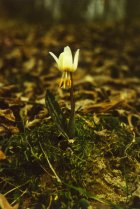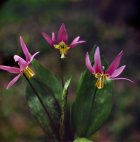 |
QUICK SEARCH
MO PROJECTS:
Africa
Asia/Pacific
Mesoamerica
North America
South America
General Taxonomy
Photo Essays
Training in Latin
America
MO RESEARCH:
Wm. L. Brown Center
Bryology
GIS
Graduate Studies
Research Experiences
for Undergraduates
Imaging Lab
Library
MBG Press
Publications
Climate Change
Catalog Fossil Plants
MO DATABASES:
W³MOST
Image Index
Rare Books
Angiosperm
Phylogeny
Res Botanica
All Databases
INFORMATION:
What's New?
People at MO
Visitor's Guide
Herbarium
Jobs & Fellowships
Symposium
Research Links
Site Map
Search
ORNAMENTAL PLANTS OF HORTICULTURE VALUESelection of perennials
E. caucasicum Woronow Caucasus (western regions) and northern Iran. Forests of lower mountain zone, forest margins, tall grass communities. Flowering stem up to 10-15 cm. Tuber- like bulb elongate or elongate-cylindrical, 2-4 cm long. Leaves (usually 2) glaucous, spotted, ovate-elongate, 4-6 cm x 2-3 cm, prostrate. Flowers solitary, white or creamy, with small scattered spots, perianth lobes lanceolate. V - April to June. Fl - April or May in St. Petersburg, March-April in the wild. P - daughter bulbs. Transplant only in late summer. Well-drained soil is desirable. Can grow in shady places. Very suitable for the rock garden and group plantings as a spring flower. Z 5 (4). New. E. sibiricum (Fisch. et C. A. Mey.) Kryl.
Siberia (Altay, Western Sayan), Central Asia (eastern Kazakstan) and Mongolia. On rocky slopes, forest edges. Flowering stem 15-30 cm. Tuber-like bulb elongate-ovate, above 3-6 cm long. Leaves 2, elliptical, with reddish spots, 10-20 cm x 3-7 cm. Flowers solitary, dark pink or lilac, 5-6 cm diam. Perianth lobes with numerous minute spots, inner segments with auricules. Anthers yellow, in contrast to the Europaean species E. dens-canis, which has dark lilac or brown anthers. V - April to July. Fl - end April, or beginning of May. Fr - June-July. P - by daughter bulbs and seed. Needs well-drained soil. A white-flowering form occurs in the wild. Once established, it can grow for many years in the same place and cover large patches. Good in rock gardens and flower beds. Z 3. New. |
||||
| SELECTION OF PERENNIALS |
© 1995-2025 Missouri Botanical Garden, All Rights Reserved
4344 Shaw Blvd.
St. Louis, MO 63110
(314) 577-5100
Technical Support

